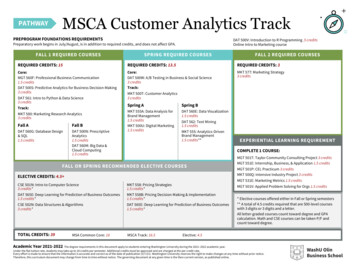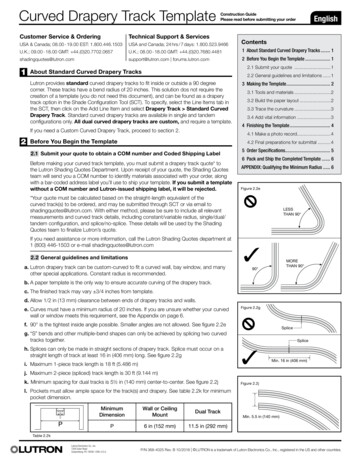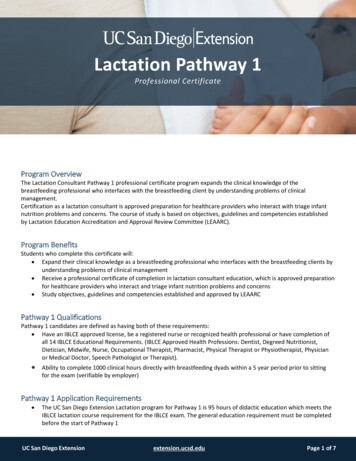
Transcription
PATHWAYMSCA Customer Analytics TrackPREPROGRAM FOUNDATIONS REQUIREMENTSDAT 500V: Introduction to R Programming .5 creditsOnline Intro to Marketing coursePreparatory work begins in July/August, is in addition to required credits, and does not affect GPA.FALL 1 REQUIRED COURSESSPRING REQUIRED COURSESFALL 2 REQUIRED COURSESREQUIRED CREDITS: 15REQUIRED CREDITS: 13.5REQUIRED CREDITS: 3Core:MGT 560F: Professional Business Communication1.5 creditsDAT 500S: Predictive Analytics for Business Decision-Making3 creditsCore:DAT 500W: A/B Testing in Business & Social Science3 creditsTrack:MKT 577: Marketing Strategy3 creditsDAT 561: Intro to Python & Data Science3 creditsTrack:MKT 580: Marketing Research Analytics3 creditsFall AFall BDAT 560G: Database Design& SQL1.5 creditsDAT 500N: PrescriptiveAnalytics1.5 creditsDAT 560M: Big Data &Cloud Computing1.5 creditsMKT 500T: Customer Analytics3 creditsSpring ASpring BMKT 555A: Data Analysis forBrand Management1.5 creditsMKT 500U: Digital Marketing1.5 creditsDAT 560E: Data Visualization1.5 creditsDAT 562: Text Mining1.5 creditsMKT 555: Analytics-DrivenBrand Management1.5 credits**COMPLETE 1 COURSE:FALL OR SPRING RECOMMENDED ELECTIVE COURSESELECTIVE CREDITS: 4.5 MGT 501T: Taylor Community Consulting Project 3 creditsMGT 551E: Internship, Business, & Application 1.5 creditsMGT 501P: CEL Practicum 3 creditsMKT 500Q: Intensive Industry Project 3 creditsMGT 531E: Marketing Metrics 1.5 creditsCSE 501N: Intro to Computer Science3 credits*MKT 558: Pricing Strategies1.5 credits*DAT 565E: Deep Learning for Prediction of Business Outcomes1.5 credits*MKT 558B: Pricing Decision-Making & Implementation1.5 credits*CSE 502N: Data Structures & Algorithms3 credits*DAT 565E: Deep Learning for Prediction of Business Outcomes1.5 credits*TOTAL CREDITS: 39MSCA Track: 16.5MSA Common Core: 18EXPERIENTIAL LEARNING REQUIREMENTMGT 501V: Applied Problem Solving for Orgs 1.5 credits* Elective courses offered either in Fall or Spring semesters** A total of 4.5 credits required that are 500-level courseswith 3 digits or 3 digits and a letter.All letter-graded courses count toward degree and GPAcalculation. Math and CSE courses can be taken P/F andcount toward degree.Elective: 4.5Academic Year 2021-2022 The degree requirements in this document apply to students entering Washington University during the 2021–2022 academic year.Under the flat tuition rate, students may take up to 18 credits per semester. Additional credits must be approved and are charged at the per credit rate.Every effort is made to ensure that the information is accurate and correct as of the date of publication (5/7/21). Washington University reserves the right to make changes at any time without prior notice.Therefore, this curriculum document may change from time to time without notice. The governing document at any given time is the then-current version, as published online.
MSA - Customer Analytics Course DescriptionsSummer Foundations WorkshopDAT 500V Introduction to R ProgrammingR has become the tool of choice for many data science and customer analytics professionals in every industry and field. Itis not surprising to see a requirement for being familiar with R in job descriptions. R is very flexible in carry out dataanalysis. Part of the benefit of being open source is that many programmers/researchers are constantly introducing newstatistical analysis tools into R through R packages. Given all the benefits, R does have a relatively steeper learningcurve. To better prepare MSA students, we introduce this 2 day introduction to R programming course. This class will helpyou master the basics of R. We will start from the very beginning - installation of the program. No prior knowledge inprogramming is required. Through in class demonstration and lots of hands-on practice, by the end of the second day,you will have the chance to undertake your own data analysis and solve relevant business problems using R. 0.5 credits.Graded Pass/Fail.Online Introduction to MarketingCommon Core CoursesDAT 560G Database Design and SQLDatabases are at the foundation of every organization's information strategy. Understanding the structure of databasesand mastering the tools to analyze data are essential skills in any role. The tools developed in this course assist studentsin implementing a company's data management strategy and developing well-grounded analytical recommendations. Inthis course we focus on understanding how data is structured in relational databases. With vast amounts of dataavailable, from disparate sources, effective organization of the data is essential to its utilization. To complement this, weutilize SQL (Structured Query Language) as the primary tool to extract data for managerial reports and for advancedanalytical models. Practical experience with current relational database software is developed throughout the course. Thiscourse is required for MS/CA students and priority will be given to SMP students. 1.5 credits.DAT 500N Prescriptive AnalyticsThis course covers optimization models and tools as they apply to the design and analysis of supply chains. Productionplanning, distribution, network design, and revenue management problems are covered using the methods of linear, nonlinear, and integer programming. Upon successful completion of this course, students will demonstrate competency informulating and solving supply chain optimization models of real-life complexity using state-of-the-art software. They willbecome proficient with industrial strength software tools like AMPL and Gurobi alongside Excel’s Solver. The courseemphasizes proficiency in model-building and using software tools rather than theory. 1.5 creditsDAT 560M Big Data & Cloud ComputingThe growth in available data is a challenge to many companies. This presents an opportunity for companies to conquerthe vast and various data available to them. The growth in data includes traditional structured data, as well asunstructured data created by both people and machines. It is essential for analysts to be comfortable in the newtechnologies and tools that are being developed to store, retrieve, analyze, and report, using the vast data resourcesavailable. This course introduces students to the technologies currently deployed to overcome the challenges of Big Data.Prerequisite: MGT 560G. 1.5 credits.MGT 560F Professional Business CommunicationCommunication is the process of sending and receiving messages, however, communication is effective only when themessage is understood and when it stimulates action or encourages the receiver to think in a new way. This course willintroduce students to fundamental best practices in business writing and business speaking that will ensure effectivecommunication. Students will participate in activities that will develop professional business communication skills in bothwriting and speaking. These will include: preparing, writing and delivering presentations, composing clear concisebusiness messages in a variety of formats, understanding emotional intelligence to reach the audience and utilizing criticalthinking as a basis for communication strategies. 1.5 credits.DAT 500S Predictive Analytics for Business Decision-MakingPredictive Analytics deals with the employment of formal learning from business experience, using business data, topredict the future behavior of customers or other critical organizational elements in order to drive better businessdecisions. This course emphasizes data situations that students are likely to face in marketing, finance, manufacturingand consulting jobs. Students will analyze real-world business datasets using various advanced analytic techniques such
as logistic regression, decision trees, neural networks, stochastic gradient boosting, MARSplines, Ensembles, Clustering,Associations etc. The focus of the course lies in the conversion of raw and messy business data in to robust actionablepredictions for decision-making. 3 credits.DAT 561 Introduction to Python and Data ScienceThis is a 3-credit course offered to MSBA students. It provides students the necessary skill set to extract reliable insightsfrom large datasets prevalent in various business applications, such as supply chain management, marketplaceoperations, healthcare analytics and financial engineering, using Python. In this course, students will develop basic toolsto understand Python programs and implement data processing pipelines using Python. In particular, students will learnhow to acquire, clean, analyze and visualize data in Python, which they will then use to improve decision-makingprocesses. Throughout the course, students will use the Python programming language, which is very effective for datamanipulation, reporting, and complex optimization. Topics covered include introduction to Python programming, dataacquisition and cleaning, data manipulation, current multi-source data collection technology used in practice, basic datavisualization using Matplotlib, ggplot2 and Bokeh. 3 credits.DAT 560E Data Visualization for Business InsightsData Visualization has become a core skill set to derive business insights in the data rich business world. Organizationsare expecting Business Analysts and Managers to create and disseminate insightful visualizations about the business.This course teaches students the necessary skill set to create insightful visualizations using Tableau to understandpatterns prevalent in large datasets which are otherwise difficult to comprehend. In particular, students will learn how tochoose and create appropriate visualization based on the following three criteria: 1. Who's the audience looking at thevisualization? 2. What is the nature of the business goal (Descriptive, Predictive, or Prescriptive)? 3. What is the data(Categorical, Numerical, Time Series, etc.)? The course will expose students to prevalent business applications of datavisualization in different domains (Customer Analytics, Supply Chain Analytics, Healthcare Analytics, FinancialTechnology Analytics, Accounting Analytics, Talent Analytics etc.). Upon completing this course, students will know howto create insightful dashboards and other visualizations for different audiences from the given data according to thespecified goal. 1.5 credits.DAT 562 Text MiningConsumers and companies constantly generate large amounts of unstructured or lightly structured texts on the web andoffline: exchanges of consumer opinions on products and services on social media, transcripts of phone conversationswith customer representatives, open-ended surveys, etc. By employing text analytics, businesses can derive at scalevaluable insights into consumer attitudes to brands, competitive landscape, and customer relationships, among otherapplications. This course introduces students to the methods of mining, organizing, summarizing, and analyzing textualdata with the objective of driving business decision-making. 1.5 credits.DAT 500W A/B Testing in Business and Social ScienceThis course introduces students to causal methods that are used to measure the impact of business and policy decisions.The key insight of the course is that correlation does not imply causation and therefore cannot measure impact. In thisclass, we will learn about A/B testing and other causal methods, as well as how to implement them in business, economic,and policy situations. 3 credits.Track Required CoursesMKT 580 Marketing Research AnalyticsThis course is designed to provide you with an appreciation of the role of marketing research (MR) in the formulation andsolution of marketing problems. In this course, you will be developing basic skills in conducting and evaluating marketingresearch design, alternative methods of data collection, and data analysis techniques. 3 credits.MKT 555A Data Analysis for Brand ManagementToday’s brand managers typically have access to large quantities of data. For example, managers of consumer packagedgoods brands typically have access to supermarket scanner data that cover thousands of daily transactions in hundredsof product categories at the store. Careful analyses of such data lead to an improved understanding of the marketplaceand, in turn, improve the quality of marketing decisions. This course will cover statistical models and techniques that canbe effectively used by brand managers on large marketing datasets. While the focus will be on fast-moving packagedgoods categories (coffee, laundry detergents, carbonated beverages, etc.), the course will also deal with durable goods(automobiles), entertainment products (movies), etc. Microsoft Excel will be used for analysis. 1.5 credits.MKT 500U Digital MarketingThe aim of this course is to provide a rigorous and comprehensive introduction to technology and methods of conductingmarketing activities online. Specific objectives are to introduce students to: (1) Concepts and terminology of digital
marketing; (2) Specifics of online consumer behavior and internet-based business models; (3) Hands-on experience increating and running advertising campaigns in social media. 1.5 credits.MKT 555 Analytics-Driven Brand ManagementThis course will cover decision support tools that can be effectively used by brand managers to improve the quality of theirmarketing decisions, such as pricing, advertising, promotions, etc. These decision-support tools typically rely on marketbased estimates of demand and competitive conditions, which are often obtained by analyzing historical transactions data(which is the focus of MKT 555A: Data Analysis for Brand Management) and sometimes using consumer surveys (whichis the focus of MKT 571A: Marketing Research I). The focus of this course will be on the optimization of marketingresources and budgets given such a quantitative understanding of the marketplace. While the focus will be on fast-movingpackaged goods categories (coffee, laundry detergents, carbonated beverages, etc.), the course will also deal withdurable goods (automobiles), entertainment products (movies), etc. Microsoft Excel will be used for analysis. 1.5 credits.MKT 500T Customer Analytics Using Probability ModelsCustomer analytics is about using customer data to make business decisions and predict future behavior. This course willbuild and implement powerful and leading-edge models for customer acquisition, retention, behavioral patterns such aswebsite visits, customer lifetime value and direct marketing responses. The course will provide a unifying framework forthinking about customer data analysis and develop hands-on experience in model building and estimation using MicrosoftExcel. These models use basic building blocks from probability theory to offer behaviorally plausible perspectives on whatpeople buy, when they buy, and how much they buy. Anyone with interest in the revenues generated by customers (suchas managers, consultants, analysts and investors) can benefit from deeper insights and more accurate forecasts thatresult when accounting for these patterns in their models. 3 credits.MKT 577 Marketing StrategyMarketing strategic decisions require long-term planning and are often costly to change once implemented. They ofteninvolve more than one marketing mix variable (price, advertising and other promotions) that have to be consistent with afirm’s core competencies, with the objective of establishing sustainable competitive advantages. A good strategicplanning requires careful analysis of customers and competitors in the industry, identifying a feasible set of options anddeciding on a course of actions. With the development of the information technology nowadays, firms have collectedvaluable market data, either by themselves or from third-party data providers. The biggest question for most firms,however, is how to use these data to help make strategic decisions. The objective of this capstone course is to develop acomprehensive framework to help understand the strategic situations of firms and the trade-off involved in decisionmaking. It will also provide students a comprehensive knowledge of using analytical skills to solve business problems.We will explore the importance of CRM and how to use customer analysis to make marketing decisions. Other topicsincluding competitor analysis, STP, price competition, product and entry strategies will also be covered. 3 credits.Track Required Experiential Course (choose one of the following)MKT 500Q Intensive Industry ProjectStudents will work in teams on an analytics-driven client project, applying the tools that they learned in their Fall coursework to the client’s data-driven business problem under faculty and client supervision. Each student is expected to spendabout 150 hours on the project. Grades are based on the quality of the final deliverables, i.e., written report and oralpresentation. 3 credits.ElectivesDAT 537 Data Analysis, Forecasting and Risk AnalysisThis course presents a modem and contemporary coverage of several econometric models that are used for the analysisand forecasting of business data. The basic building blocks for the analysis are regression time series models. Broadcoverage of non-seasonal and seasonal ARIMA models is included. The important family of ARCH-GARCH models, usedto represent changing volatility, are also covered in detail. These models are widely used in option pricing and in otherfinancial applications. The course includes some extensions of these models to multivariable problems. Students areexposed to numerous real data sets in class and in assignments. All the models are analyzed with a popular econometricssoftware package that is employed in business. A group project is required. 3 credits.FIN 557EBlockchain is a revolutionary technology incorporating aspects of data science, economics, computer science, and law.The course allows students to obtain basic understanding of the blockchain technology and its applications tocryptocurrencies, smart contracts, and decentralized finance. 1.5 credits.
MGT 566 Research in Healthcare ManagementThis is the capstone course for the Health Management major where students learn to apply rigorous statistical andanalytical approaches to research questions in health services, but not limited to questions relating to management,finance and economics, operations, and policy. Faculty will identify several available research project options, and presentthese options in class. The goal is to capitalize on the strength of the university medical school and affiliated medicalcenters, in addition to capitalizing on existing relationships between Olin and healthcare firms to identify the studentresearch projects. Students will also be encouraged to formulate their own research question and to identify potential datasources they could use to address these questions, if they so desire. Students will work in teams of 3-4, using theapproach developed for the Practicum and Hatchery courses. 3 credits.MGT 620 Empirical Methods in Business3 credits.MGT XXX Introduction to Blockchain1.5 credits.MKT 558 Pricing StrategiesThis course is designed to equip you with some essential concepts and techniques needed to make profitable decisionsabout one of the most important marketing variables—price. This course is structured around four fundamental factorsthat firms need to consider in their pricing decisions: costs, customers, competitors, and climate (legal environment).Through case studies, in-class discussions, and course project/presentations, this course will provide you with aconceptual framework, grounded in modem economics and consumer psychology, for analyzing a complex marketingenvironment and designing proactive pricing strategies that are most profitable for a business. 1.5 credits.MKT 558B Pricing Decision Making & ImplementationThe focus of this course is on pricing tactics and strategies that are proven to be profitable for firms. Through casestudies, lectures, a pricing simulation game, and presentations, this course will help students gain insights in to successfulpricing strategies in various industries and to develop skills that are necessary to make the most important businessdecision—pricing—in their organizations. Topics of discussion include pricing innovative products, pricing and marketmaking on the internet, pricing of digital products, and dynamic and competitive pricing. 1.5 credits.OB 500E Talent AnalyticsFinding, developing, and retaining the best talent has always been the key to sustained success in business.Organizations today have potential access to far more useful information about people than ever before but most struggleto access and use it effectively. In a highly competitive global market, rigorously analyzing data to enable timely, strategicdecisions about talent provides a critical edge. In this course you will learn how to use analytics to bring data and rigorousmodelling to bear on people-related issues, such as recruiting, performance evaluation, leadership development andsuccession, job design, and compensation. Together, these can help organizations achieve long range strategic goals,rather than simply serving as an administrative support function. 1.5 credits.OB 535 People MetricsMetrics are at the core of people analytics. The purpose of this course is to introduce you to the foundations of assessingbehavior in organizations using novel measurement approaches and large datasets. Through classroom discussions andreal-world applications, this course will enable you to add value to organizations through the development, use, andinterpretation of innovative people metrics. Specifically, after taking this course, you will be able to: Develop a clear andlogical conceptual measurement model. A conceptual measurement model is the foundation of creating novel and usefulnew approaches for assessing intrapersonal characteristics (e.g., personality) and interpersonal behavior (e.g., knowledgesharing, teamwork). Identify novel sources of data for innovative people metrics. Organizations are awash in the traces ofindividual behavior and social interactions. Decoding how data that already exist in an organization can be used tounderstand behavior is an essential skill for adding value in the field of people analytics. Apply a rigorous process forvalidating new people metrics. Developing a measurement model and finding sources of data are necessary, butinsufficient for adding value through people metrics. New measures must be validated. 1.5 credits.DAT 560N Introduction to CybersecurityThis course covers a broad range of cyber security terms, definitions, perspectives, concepts, and current trends with afocus on managing risk and the use of information and cyber security as business enablers. Students will complete acybersecurity analytics-related project as part of the coursework. 1.5 credits.
OMM 500M Stochastic ModelsThis course covers the two key types of simulation models of uncertain events: Monte Carlo simulation and DiscreteEvent Simulation. The conceptual difference between these simulation methodologies is in their treatment of time.Discrete Event Simulation is used to model dynamic systems where events occur at specified, random, time. In MonteCarlo simulation the timing of events is typically inconsequential. Upon successful completion of this course, students willdemonstrate competency in formulating and analyzing stochastic models using state-of-the-art simulation software. Theywill become proficient with software tools like Arena for Discrete Event Simulation and Crystal Ball for Monte Carlosimulation. The course emphasizes proficiency in using software tools to analyze models rather than theory. 1.5 credits.OMM 520 Revenue ManagementThis course examines the core concepts of revenue management: how to accurately align product pricing, placement, andavailability with a retailer’s perception of consumer demand. Students will be introduced to linear and dynamicprogramming as a means to model a variety of capacity allocation and pricing problems that are relevant to airline, hotel,or restaurant industries. Specifically, most problems will be framed within the context of the single resource and networklevel revenue management problems. For the single resource problem, we will derive efficient exact solution methods andalso consider a variety of extensions to the original model which incorporate overbooking and no-show behavior. For thenetwork problem, we will learn how to extract near-optimal, and easily implementable policies from deterministicapproximations. While the main goal of this course is to provide insight into industry specific problems, another centralobjective is to introduce students to concepts such as robust optimization and approximate dynamic programming toexpand their breadth of modeling tools. Moreover, students will learn how to use Python to solve complex and industrylevel optimization problems with data. At the successful completion of this course, students should feel confident modelingand analyzing a broad series of stochastic optimization problems. Students should also feel comfortable with using Pythonto make revenue management decisions with data. Beyond studying and analyzing classical RMP problems the studentswill gain valuable computational skills. Students will be asked to code up dynamic programming formulations, solve largescale linear programs with Python (coupled with Gurobi) and use machine learning techniques for demand estimation andforecasting. 3 credits.CSE 222S Internet of ThingsFor a very long time, the Things in our world have lived relatively lonely and single-purposed lives. With the advent of theInternet of Things, we can address, control, and interconnect these formerly isolated devices to create new and interestingapplications. In this course we study Bluetooth Low Energy, one of the fundamental networking technologies behindInternet-of-Things devices, and Appcessories, which include smart watches, health monitors, toys, and appliances. Inaddition to learning about the Bluetooth Low Energy protocol and network stack, students gain hands-on experiencedeveloping multi-platform solutions that control and communicate with Things using an accompanying app on a mobiledevice. Students apply their knowledge and skill to develop a project of their choosing using topics from the course.Prerequisite: CSE 132. 3 credits.CSE 316A Social Network AnalysisThis course looks at social networks and markets through the eyes of a computer scientist. We will look at questionsincluding, "Why are acquaintances rather than friends more likely to get us job opportunities?" and, "Why do the rich getricher?" We begin by studying graph theory (allowing us to study the structure) and game theory (allowing us to study theinteractions) of social networks and market behavior at the introductory level. Among other topics, we will study auctions,epidemics, and the structure of the Internet (including web searches). This course examines the intersection of computerscience, economics, sociology, and applied mathematics. 3 credits.CSE 417T Introduction to Machine LearningThe field of machine learning is concerned with the question of how to construct computer programs that automaticallyimprove with experience. This course is a broad introduction to machine learning, covering the foundations of supervisedlearning and important supervised learning algorithms. Topics to be covered are the theory of generalization (includingVC-dimension, the bias-variance tradeoff, validation, and regularization) and linear and non-linear learning models(including linear and logistic regression, decision trees, ensemble methods, neural networks, nearest-neighbor methods,and support vector machines). Prerequisites: CSE 502N, ESE 326 or Math 3200, Math 233, and Math 309 (can be takenconcurrently). 3 credits.CSE 427S Cloud Computing with Big Data ApplicationsThis course provides a comprehensive introduction to applied parallel computing using the MapReduce programmingmodel facilitating large scale data management and processing. There will be an emphasis on hands-on experienceworking with the Hadoop architecture, an open-source software framework written in Java for distributed storage andprocessing of very large data sets on computer clusters. Further, we will make use of related big data technologies fromthe Hadoop ecosystem of tools, such as Hive, Impala, and Pig in developing analytics and solving problems faced byenterprises today. Prerequisites: CSE 501N, CSE 502N, and CSE 503S. 3 credits.
CSE 501N Introduction to Computer ScienceAn introduction to software concepts and implementation, emphasizing problem solving through abstraction anddecomposition. Introduces processes and algorithms, procedural abstraction, data abstraction, encapsulation, and objectoriented programming. Recursion, iteration, and simple data structures are covered. Concepts and skills are masteredthrough programming projects, many of which employ graphics to enhance conceptual understanding. Java, an objectoriented programming language, is the vehicle of exploration. Active-learning sessions are conducted in a studio setting inwhich students interact with each other and the professor to solve problems collaboratively. Prerequisites: Comfort withalgebra and geometry at the high school level is assumed. Patience, good planning, and organization will promotesuccess. This course assumes no prior experience with programming. 3 credits.CSE 502N Data Structures and AlgorithmsStudy of fundamental algorithms, data structures, and their effective use in a variety of applications. Emphasizesimportance of data structure choice and implementation for obtaining the most efficient algorithm for solving a givenproblem. A key component of this course is worst-case asymptotic analysis, which provides a quick and simple method fordetermining the scalability and effectiveness of an algorithm. Prerequisite: CSE 501N. 3 credits.CSE 503S Rapid Prototype D
DAT 500S: Predictive Analytics for Business Decision-Making 3 credits DAT 561: Intro to Python & Data Science 3 credits Track: MKT 580: Marketing Research Analytics 3 credits Fall A DAT 560G: Database Design & SQL 1.5 credits Fall B DAT 500N: Prescriptive Analytics 1.5 cre










